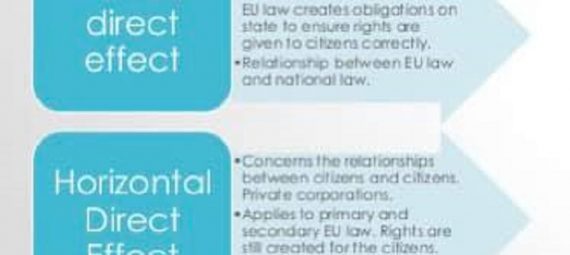LIANNA MELKEER AMIRKHANYAN
As it is known, the EU Law is Supreme. It is also confusing, in terms of when it comes to the Individuals, and the principles of Direct effect explain this confusion more precisely.
The EU has 2 types of Direct Effects
1. Vertical Direct Effect, which goes up and down
2. Horizontal Direct Effect, which goes left and right
The individuals, who want to enforce their right to the EU Law against the State, can be only in the category of Vertical Direct Effect.
The Individuals, who want to enforce their rights in the EU Law against the individuals on the same level as they are, can be only be in the category of the Horizontal Direct Effect.
As the Companies have cooperate legal personality, they can be counted as an individual themselves. Therefore, this law allows the individuals enforce their rights to the other against companies, besides against the individuals.
How the Horizontal and Vertical Direct Effect work with different types of EU Law, Treaties and relevant.
How Vertical and Direct Effects can be applied in the diverse EU Law and as we all know the most important are the Treaties.
The
• Primary Legislation of the EU
Is important, as it has Horizontal Direct Effect, which you can find in the famous work of
Van Gen den Loos (1963)
The treaties articles have to be
– Clear and unconditional
– Prohibition
– Not dependent on member state implementation
An example of this is article 30, which states a prohibition on Custom duty, its unconditional and clearly prohibitional as well as it did not require any member state implementation. He was able to enforce their rights under the EU Law within the Dutch Court System.
The Regulations are relatively similar as well, when regulation is passed by the EU Law they automatically become the part of the EU Law, but they also automatically become EU Member state law, because this Direct applicable regulation have also horizontal and vertical effect.
Regulations
– Automatically part of the EU Law and Member State Law
– Horizontal and Vertical Direct effect
Directives are more complicated. They require member states do something within a certain time limit of passing their own law on subject such as equality of rights and etc.
• Must Give Rights to Individuals
– Dedrebbe v Sabena (No.2). (1979)
• The Time Limit must have passed
– Pubblico Ministerio v Raffi (1979)
Because of the requirements to their member state to do something, they only have Vertical Direct Effect.
Directives:
In order to be enforceable by an individual, have to give rights to those individuals, and also time limit the member state has, has to be expired;
Meaning; it has to come beyond the time limit, and then individuals can enforce their rights.
Author Profile
- Emanuele Lombardini is our blog editor-in-chief. He is an experienced journalist, a Libdem, Italian and passionate European.
Latest entries
Post Disclaimer
The opinions expressed by the author of this post do not necessarily represent the opinions and policies of ELfR.





